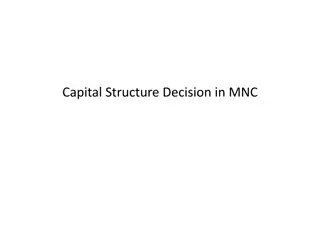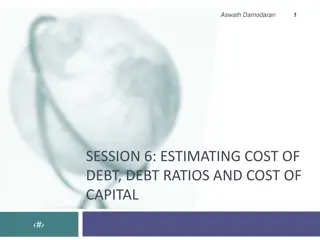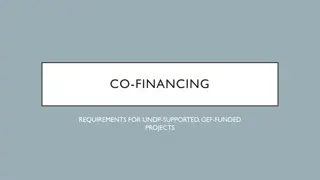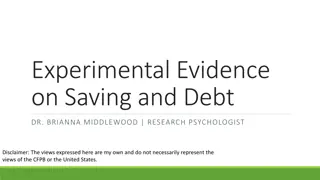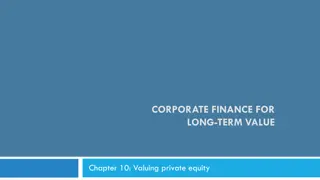
Sources of Permanent Financing for Business Growth
Explore the various sources of permanent financing including debt and equity options, commercial lending processes, and the pros and cons of leasing. Learn about different funding avenues such as commercial mortgage loans, venture capital, government financing programs, and more to support your business expansion.
Download Presentation

Please find below an Image/Link to download the presentation.
The content on the website is provided AS IS for your information and personal use only. It may not be sold, licensed, or shared on other websites without obtaining consent from the author. If you encounter any issues during the download, it is possible that the publisher has removed the file from their server.
You are allowed to download the files provided on this website for personal or commercial use, subject to the condition that they are used lawfully. All files are the property of their respective owners.
The content on the website is provided AS IS for your information and personal use only. It may not be sold, licensed, or shared on other websites without obtaining consent from the author.
E N D
Presentation Transcript
Maturity Matching Concept A Current assets B Long-term assets C Current liabilities D Permanent debt financing E Permanent equity financing A minus C = Net working capital F Temporary financing 2
Sources of Permanent Financing Debt Equity Commercial mortgage loans Term loans Syndicated loans Mezzanine financing Bridge loans Project financing Securitization Leases Bonds, notes, debentures Self-funding Crowdfunding Private equity Angels, incubators, accelerators Venture capital Franchising Retained earnings Preferred and common shares Dividend re-investment plans Rights offerings Warrants, stock options Limited partnerships Joint ventures and strategic alliances Employee stock ownership plans (ESOPs) Government Financing Programs Business Development Bank of Canada (BDC) Export Development Corporation (EDC) Canadian Small Business Financing Loan (CSBFL) Private Placements Public Placements 3
Commercial Lending Sources of Commercial Lending Lending and Loan Monitoring Process Step 1 Comprehensive review of business environment Step 2 Analysis of company and its financial statements Step 3 Preparation of financial projections with sensitivity analysis Step 4 Final credit risk assessment Step 5 Interest rate determination Step 6 Preparation of loan agreement Step 7 Monitoring the loan Chartered banks Credit unions Institutional lenders Life insurance companies Pension funds Trust companies Types of Lending Asset-Based Cash-Flow Based 4
Leasing Pros and Cons of Leasing Capitalizing Leases Financing flexibility Operational flexibility Lessor expertise Lending restrictions Tax savings Cost Real estate Contractual disputes All leases are capitalized unless they are less than 12 months or of low value Asset and liability are equal to the present value of future lease payments Discount rate used is the implicit rate in the lease or the incremental borrowing rate if that is not available Operating Versus Financial Leases Accounting for Leases Total asset turnover ratio Debt-to-total-assets ratio Rate of return on assets 5
Calculating Lease Payments Lease Payment Formula Value of asset PV of CCA tax shield = PV of after-tax lease payments + PV of residual value Present Value of CCA Tax Shield CCA rate CCA rate+RRR) ( 2 + RRR 2 (1+RRR)) Present value of CCA tax shield = (Investment) (Marginal tax rate) ( 6
Lease or Buy? Companies should do a comparison of leasing versus buying an asset to determine which form of financing is the most affordable A differential analysis that is very similar to the process followed in capital budgeting is used Tax Law for Specified Leasing Property A lessor of exempt assets can deduct full CCA, but a lessor of non-exempt assets is limited to the lower of: CCA Principal a lessor receives if a lease is treated as a loan is equal to the fair value of the leased asset discounted at the prescribe rate Lessee can elect to be treated as the owner of a non-exempt asset for tax purposes allowing them to deduct both interest and CCA These rules begin to harmonized the accounting treatment for leases under the ITA and IFRS 7
Corporate Bond Financing Bonds Versus Commercial Loans Bond Features Why bonds? Covenants Callable bonds Convertible bonds Bond sinking funds Credit ratings Collateral Subordination Guarantees Lower interest costs by borrowing directly More liquid investment further lowering interest rates Fewer lending covenants and less rigorous monitoring Longer term financing Why commercial loans? Can be arranged quickly Accessible to small lenders due to lower issuance costs Customized repayment is more possible Agreements can be more easily modified No expensive bond ratings No public disclosures of company information 8
Equity Financing Liability or Equity Any financing with a required payment is classified as a liability and not equity Rights Offerings Why rights? Avoid high issuance costs Allow current shareholders to retain the same percentage ownership and not fear loss of control May be required by a company s articles of incorporation Theoretical value of a right = (Share price during rights on period Subscription price) (Number of rights required to buy one new share + 1) 9








